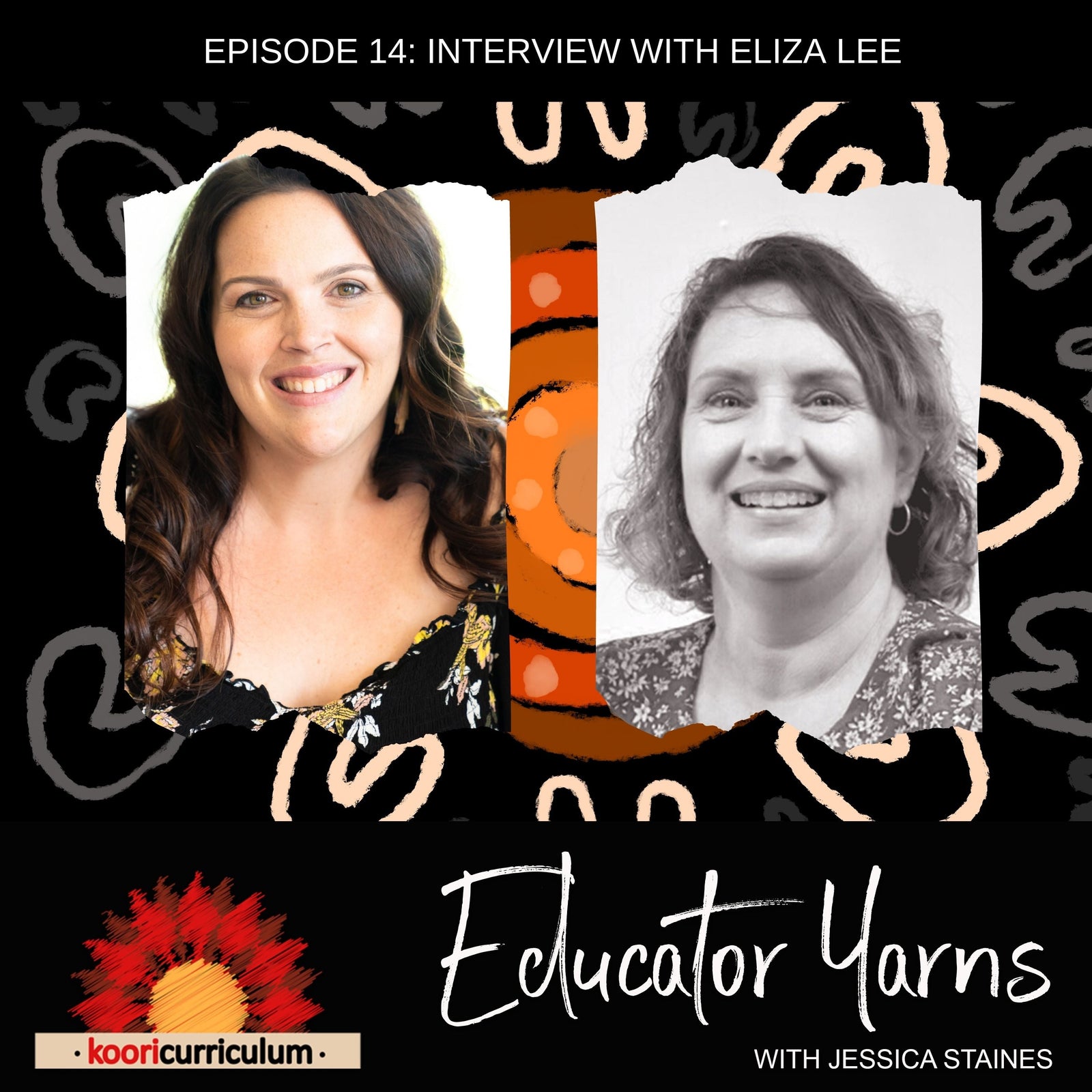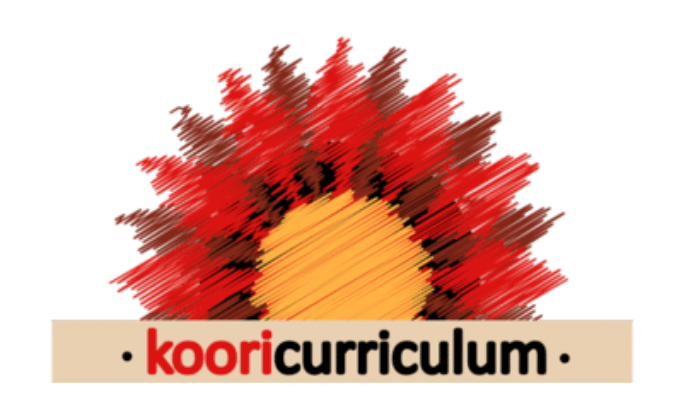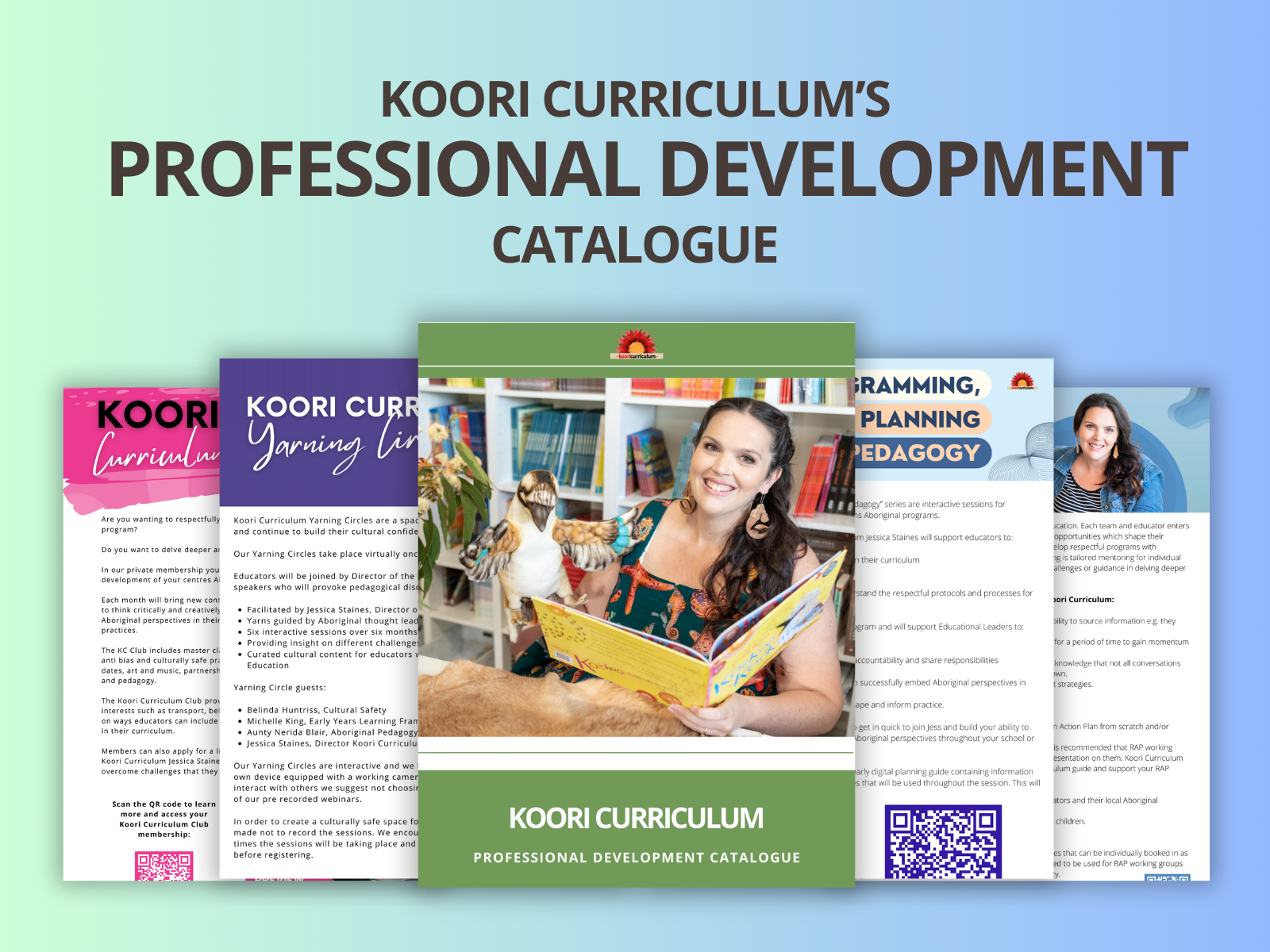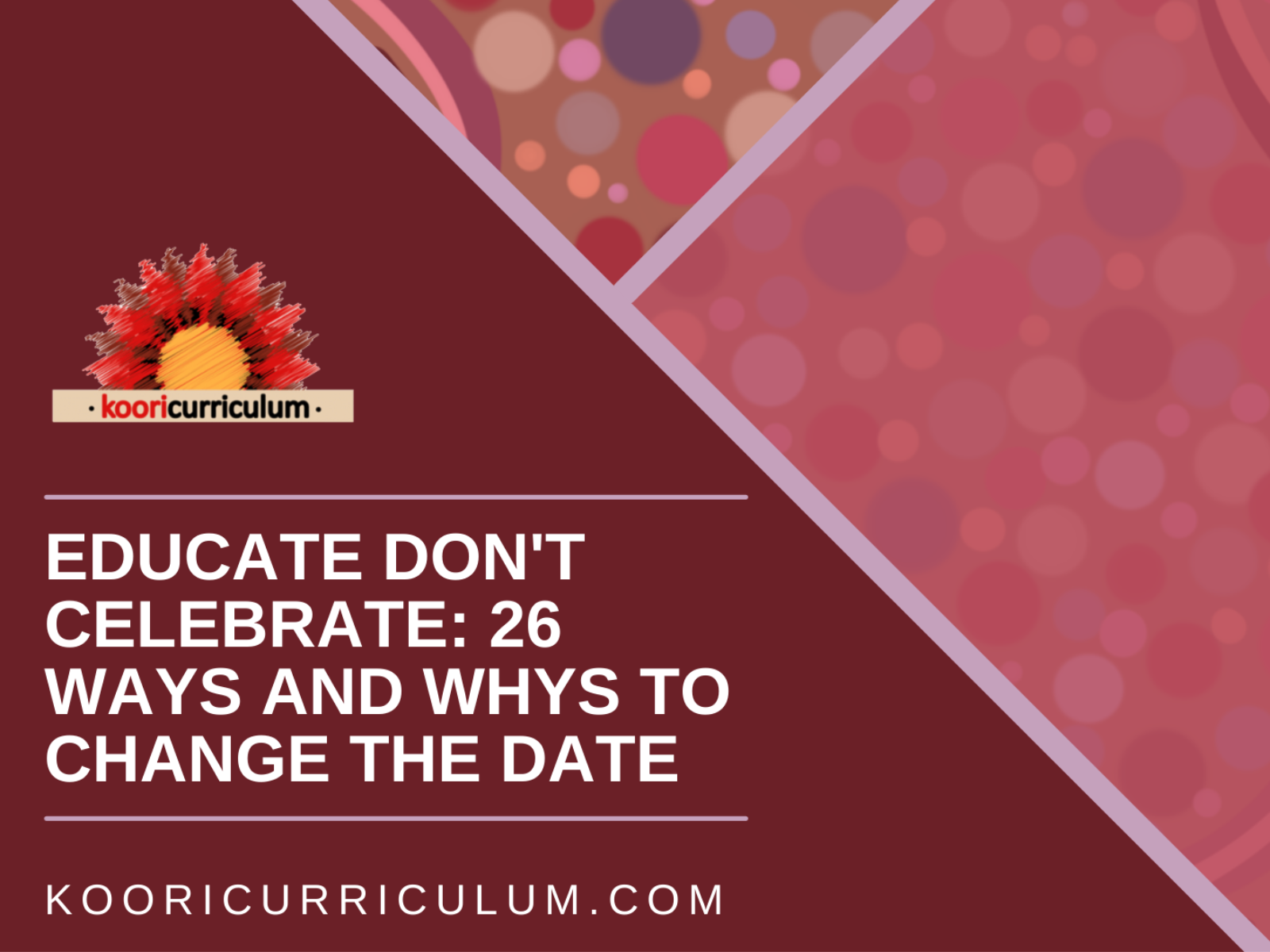
Educator Yarns Season 2 Episode 14: Interview with Eliza Lee
On Educator Yarns today Jessica speaks with Eliza, an educator working with under threes on Wurundjeri country in the Yarra Valley
Eliza speaks specifically about how she began her journey into this often overlooked age group and ways she found using language and visuals to meaningfully connect children in a respectful manner to the Aboriginal Community that surrounds her service.
SHOW NOTES
Eliza:
What organisation is around in your area that can help you on Aboriginal organisation that can help?
Jessica Staines:
Centric and ethical resources that they can stand behind that will support them in their programme.
Eliza:
Right at into some of the rural language, which is no [inaudible 00:00:21]
Jessica Staines:
Use them as a catalyst to begin talking about, Aboriginal culture.
Speaker 1:
You're listening to the Koori Curriculum, Educator Yarns with Jessica Staines.
Jessica Staines:
I'd like to acknowledge the darker young people, the traditional owners of the land on which I am recording these podcasts. I pay my respects to their elders both past, present, and emerging, and pay my respects to all Aboriginal and Torres Strait Islander listeners.
Hi everyone. My name is Jessica Staines, Director of the Koori Curriculum. For those of you that aren't familiar with our podcast, Season Two is all about our new book, Educator Yarns, where meeting and interviewing with the educator contributors from right around Australia, who will be sharing little snippets of their piece. It will be a combination of stories about why embedding Aboriginal perspectives is so important, how to connect with local community, how to embed Aboriginal perspectives in our programme, how to work with anti-biassed approaches and so much more. So make sure you listen in and enjoy the episode. Bye for now.
Hi everyone. So today we are welcoming a live out onto our podcast and we are going to be yarning about the piece that she wrote for our new book, Educator Yarns. So welcome Eliza, thanks so much for joining us.
Eliza:
Thank you for inviting me.
Jessica Staines:
So I thought we'd just begin. If you could introduce yourself and let our listeners know where you work and a little bit about your context.
Eliza:
Okay. So I'm a three-year-old kinder teacher on the [inaudible 00:02:05], which is in the Yarra Valley. And so I have 19 three-year-olds each year and I'm also a trainer and assistant for one of our local RTOs and I trained and assessed it teaching Certificate III in early toddler and diploma.
Jessica Staines:
Oh great. Yeah. So my mum said head teacher of child studies at our local TAFE. And I also teach a little bit at TAFE as well.
So I love it when I talk to other trainers because they get all the fresh students that are coming in. Do you get a lot of international students in the Yarra Valley as well?
Eliza:
No, so most of ours are local families. So the local ladies that often do it and also within the early childhood Certificate III and the diploma. And I also train in working with Aboriginal and Torres Strait Islander families.
Jessica Staines:
Oh, great. [crosstalk 00:03:03].
Eliza:
That's my little niche. However, the first thing I do, state that I don't have any Aboriginal heritage in me, but it is a passion of mine, so.
Jessica Staines:
Yeah. Great. So how did you become passionate about Aboriginal culture? What was your starting point for you?
Eliza:
I think my starting point was way back in primary school, we had a fantastic teacher that would take us on walks and explain what the Aboriginal people might've been doing on this land. So I lived down on the [inaudible 00:03:41] oh, now I can never pronounce the word right. But it's [inaudible 00:03:43] land. Yeah. And yeah. So he would talk about them, they'd collect the seashells and if they'd be eating on the beach and [crosstalk 00:03:56] beautiful ways. Yeah. [crosstalk 00:04:00]
Jessica Staines:
Well, isn't that lovely that a teacher was the start of your passion for Aboriginal culture. And now you're becoming that for the children that you're teaching. That's really lovely. So I guess what struck me about the submission that you sent through, what really stood out to me anyway, is that you were talking specifically about teaching that three-year-old age group. And I really feel that zero to threes are an age group that's underrepresented in terms of Aboriginal programmes. There's often a really big emphasis on preschool and I know that a lot of educators really struggle to find meaningful ways to embed Aboriginal perspectives for birth to threes. Would you agree with that?
Eliza:
I do. But I think now it is becoming embedded in some early childhood educators curriculum programmes. And I'm noticing in a lot of childcare centres that they are doing acknowledgement to country with the children.
Jessica Staines:
Yes.
Eliza:
Yeah. So it is getting there. And, but I think a lot of educators were very scared in what they had offered the children, whether it was saying it's tokenistic. And so, yeah. That's why I think a lot of them were scared to do things.
Jessica Staines:
Yeah, absolutely. I think that word tokenism, we need to get, be done with it, throw it away because it just puts the fear into so many educators and it really does stop them from trying. So can you share a little bit about what are some of the experiences that you provide in your programme for three year olds that celebrate Aboriginal culture?
Eliza:
All right. So I include it into my everyday speech. So it might be that they're playing with the native animals in the set up things. So they might be playing with a possum and I'll just break out into some of the rural language, which is some [inaudible 00:06:03] from their local area. And so instead of saying possum. I say, "Oh, that's the Wilai" that's what the traditional owners would call these animals. And that's how I normally bring it in is through talking about the different native animals.
Jessica Staines:
Yeah. I think that's a really meaningful way for children to begin to understand, because they're probably already somewhat familiar with Australian animals through their own home and life experiences. That it's something that they're familiar with.
So to introduce culture in a familiar way is great. And I don't know if you're a member of our Facebook group, The Koori Curriculum Educator Community, but we've actually got a mascot programme. So we have a set of 10 Australian animals and we split them up and we send them out to different early learning services. And the little Australian animal mascot say spend two weeks there. And whilst they're there, the educators use them as a catalyst to begin talking about Aboriginal culture and they document them in a little scrapbook. Then we send them off to the next centre. So the next centre that receives the mascot is looking at the scrapbook and seeing all the ways that these other services have been able to include Aboriginal perspectives in their programme. So it's a way that we're all sort of linking and joining in together. And we've really found that Australian animals have been a great vehicle to begin those conversations and linking with young children.
Eliza:
Yes. I hope so and they just looked so good.
Jessica Staines:
Yeah, they're very cute. So I was going to also have a yarn with you because when you sent through your submission, you have a beautiful photo of Bunjil that you've sent through to us, which can you tell us a little bit about that piece of transient art that you created with natural materials? What's the story behind the photo?
Eliza:
Well the story with behind the photo with local council have acknowledged that I'm one of the delayed early childhood educators in the area. And so they approached me is how could we incorporate reconciliation week with the young children.
So my colleague and I, we decided that we would go walk in our local park, which does have the sculpture and Aboriginal scope to that was opened by one of our local elders and the Manna Gum leaves. And so we thought, we'd go on this nature walk. And before we started, we did it with the children, put in natural materials and native materials in the shape of Bunjil the Eagle, which was knowing him run free land as to the Creator. And so that's how we started off and then as they walked along, we gave each of the children a Manna Gum leaf that's what they are known in this area, the Manna Gum people, we ended up at the statute of it. And there we read Welcome to Country by one about the story books by one of our elders, Aunty Joy Murphy Wandin, Welcome to Country. And we read that story there. And then we subs, we also sing songs like The Little Green Frog, but we change word frog, into a rural language. Yes. And that's what we did. And three kinders participated on that day.
Jessica Staines:
Oh, great. And I think it's such an important time to find ways to make that meaningful. And I know Aunty Joy Murphy's book is such a great resource for early childhood educators to really talk to children about the difference between an acknowledgement of and a Welcome to Country. And the illustrations alone are just stunning. So we actually sell that in the Koori Curriculum shop. We've just gotten it in to start getting that out there to educators in our network as well, because it's phenomenal. So I particularly liked that story. Do you mind sharing with us, do you have any tips for educators that are just beginning? What would be your one tip that you would give them to start their journey?
Eliza:
Well, to start would be to find out what lane you are working on or where you're living, find out what organisation is around in your area that can help you on Aboriginal organisation that can help you. So with that reconciliation, when I came in, council approached me, I still went over to our local Aboriginal community HICSA in Healesville and asked them, but they explain what I was doing. And they gave me, "Yes, that sounds really good". So yeah. Find out that and also start collecting some resources like books and native animals that you can use.
Jessica Staines:
Yeah. Having a good collection of resources that you can use, particularly if you're not very confident. So for you, you've been doing this a long time, you know the names, you know the links and the connections that you can pull with different interests that the children have, but for educators that are just starting out, that aren't as confident. I think it's really key that they have some good quality, authentic and ethical resources that they can stand behind that will support them in their programme. I agree with you and making those community connections. And I think it's those community connections and relationships that allow you to stand behind your programme with integrity and respect showing that you've shown respect to the local community. You just haven't gone off on your own and said, "All right, well, I'm going to do this", but you're constantly checking in.
And even though you probably know that these things are okay, it's just still respectful for you to continue to check in and ask permission to do those things. So that's really key advice having good quality resources to support your teaching practise and connecting with local community. The other thing that you briefly mentioned in your article is you talked about a great resource, which has only been released in the last 12 months, I believe in Victoria called Possum Skin Pedagogy by Dr. Sue Atkinson.
Eliza:
Yes.
Jessica Staines:
Do you use that a lot in your practise?
Eliza:
Well, so what I do, is that I've read through it and say, yeah, if I can implement anything that they've offered, but it basically is that what you just stated with getting connected with the local community, Aboriginal communities will service in your area. There was another, yeah.
Jessica Staines:
Yeah, and I think it's those overarching principles that are great. And I know Dr. Sue Atkinson, she also talks really strongly about the symbolism and signalling of the Aboriginal flag and what it means to create culturally safe services and practises within early learning centres. So for people, particularly in Victoria, educators that are teaching down that way, I mean, Possum Skin Pedagogy is a great free online resource that you can access to read through and get you started with some helpful tips and ideas. So thanks so much, Eliza, for jumping on and yarning with us about your article. We're really grateful for you to being able to take the time to join us today.
Eliza:
Oh, thank you, Jessica. It's been my pleasure. Thank you.
Jessica Staines:
I hope that you enjoyed this episode and had a great little sneak peak between the pages of our new book, Educator Yarns. If you'd like to ask questions or connect with me best to join our Facebook group, The Koori Curriculum Educated Community, which is free for all of our listeners and members.
In our next episode of Educator Yarns, I'll meet with Ray and Kelly, two early childhood educators working on non-war country in the ACT and together we'll be discussing how we can include and celebrate Aboriginal culture in curriculums for children who have disabilities.



